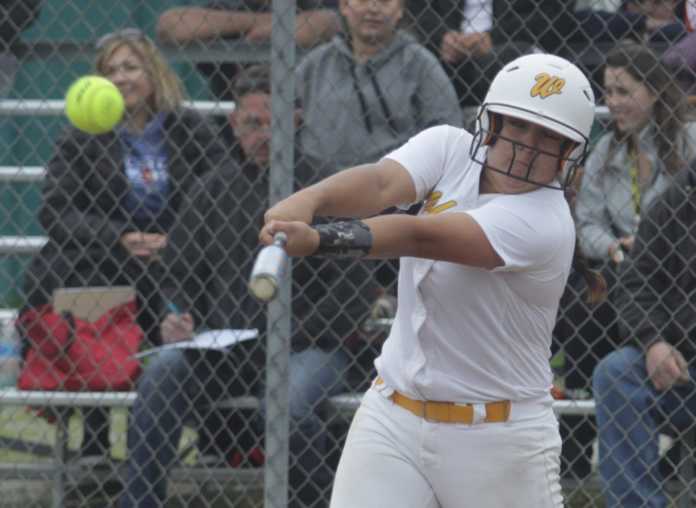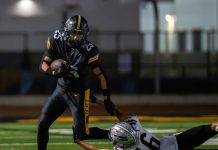In the game of baseball or softball there is no other feeling quite like demolishing the ball and watching it fly over the fence as an outfielder makes a futile run in hopes of making a snag.
Of course, I don’t say this from personal experience. I never played baseball in high school — I stop playing by the time I was 10. You know those kids in little league that sat in the outfield grass bored out of their minds? Yeah, that was me.
I’ve never hit a home run, and I probably never will — you’ll never catch me playing adult league softball, sorry. So I went around South Santa Cruz County, and asked some of the top sluggers and their coaches what it’s like to go yard, and what it takes to get the ball over the fence.
‘A DIFFERENT FEELING’
Monte Vista Christian junior cleanup hitter Roberto “Tito” Nunez has hit two homers this season. On both occasions, he didn’t need to look up to see the ball’s flight path to know it was going to leave the diamond.
“You just know,” Nunez said. “It’s a different feeling from a base hit or a double. When you hit a home run, you just feel it as soon as you swing the bat, as soon as you hit it.”
The bat, Nunez said, gives off a different vibration, your wrists shake a bit more and your swing feels pure.
“I can’t really explain it,” Nunez said.
For Watsonville senior catcher Juliana Wilson, a home run can feel like slicing into a piece of butter with a warm knife.
“Those are the best ones,” Wilson said. “Sometimes it doesn’t even feel like the ball even hit the bat, which is crazy.”
Wilson, who will play NCAA Division I softball at the University of Central Florida next season, should know. She’s hit 29 homers over the last four years — she has six through 10 games this season — and every one has been different. She’s hit plenty of “bombs.” She’s also hit a few that looked like popups. All of them elicit the same kind of raw, unexplainable emotion.
“There’s nothing really like it,” Wilson said. “It’s a great feeling because you’re helping your team win, but it’s also great to smash the ball.”
TAKING ADVANTAGE
Most home runs, M.V.C. baseball coach Don Keathley said, are mistakes.
“The pitcher leaves the ball up or inside,” Keathley said. “Good hitters will see that and can take advantage of it.”
That was the case for Nunez’s second homer of the year. A Gilroy pitcher tossed him a curve that tantalizingly hung in the air like a piñata at a birthday party.
CRAAAAACK.
“I don’t know exactly how far it went,” said Nunez, who holds a team-high on-base plus slugging percentage of 1.057. “People were telling me about 310 feet…that one’s probably my favorite.”
As the top pitcher and hitter for M.V.C.’s softball team, senior Samantha Baer didn’t dispute that. When she misses her mark against a good hitter, the ball boomerangs back over her head and out of the park.
“I’ve been on both ends,” she said through a laugh. “Obviously, one is better than the other.”
Baer, who leads the tri-county with seven homers, also said a home run in softball is typically an error on the part of the batter. Many times, she said, the trajectory on the swing of a home run has a greater upswing than a typical fundamental hack coaches teach.
“I think the real big homers, the ones that carry high into the sky, happen because you missed the ball a little bit — you didn’t get the entirety of the ball,” Baer said.
Those, as the legendary painter Bob Ross said, are happy mistakes. And they put a smile on the face of power hitters like Wilson, who, because of her reputation, sees maybe one or two hittable pitches a game.
“When I finally do get that pitch, it’s like a fat watermelon. I just want to crack it open,” Wilson said. “When I do get the chance, when they throw me something or they miss, I try to do as much damage as I can with it.”
MECHANICS, MENTALITY
That’s not to say hitting home runs is 100 percent luck. As Nunez put it: “hitting is 90 percent mental and 10 percent physical.”
Meaning?
“You can’t go up there trying to hit a home run,” said Watsonville softball coach Scott Wilson. “You have to go up there and stay true to your own mechanics, your own swing. If you do that, the home runs will come.”
He added: “Home run hitters can’t believe they’re home run hitters. They have to believe they’re good ball hitters. They put their own mechanics to good use.”
Most coaches agree that every player has their own unique swing from years of playing or lack thereof. Most coaches also believe being a good hitter is all about hands and balance — rhythm and timing, too.
“Hitting is about hands,” Keathley said. “If the timing of the legs and hands are together — and the ball is left up a little bit — then you can hit some balls that can go pretty far.”
Regardless of your height, weight or strength — although those things do help.
“I’ve seen girls that you wouldn’t think could hit home runs smash some of the deepest shots,” said M.V.C. softball coach Shelley Chavez. “Being big and strong definitely helps some girls muscle the ball out, but if you have everything else right that tends to make up the difference.”
THE FIRST ONE
Juliana Wilson can’t remember the exact date of her first home run — she said she was about 9 playing recreational softball at Rolling Hills Middle School — but she definitely recalls the feeling.
“It was the best experience ever,” Wilson said. “I was like, ‘oh my God, I hit a home run. I can do it.’”
The fence she cleared: roughly 150 feet.
“It felt like a bomb,” she joked.
Nunez was slim in his younger years and couldn’t quite get the ball over the fence. He didn’t hit his first home run — a solid line drive at the smallish Twin Creeks diamond in Sunnyvale — until last summer. It was a moment he won’t forget.
“It was something special,” Nunez said.
I’ll take your word for it.










